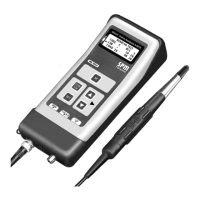51
Technical data are subject to change without notice.
ISO 9001 certified. © Copyright SPM 1996-9. 71411.B
SPM Instrument AB • Box 4 • S-645 21 Strängnäs • Sweden
Tel +46 152 22500 • Fax +46 152 15075 • info@spminstrument.se • www.spminstrument.se
Irregular Measuring Results
Fig. 36
Fig. 37
Fig. 38
Large variations between consecutive readings are a
danger sign. Damaged bearings do not improve with
time, although their shock values may temporarily
drop.
Large Drop in the Readings
If the shock pulse level drops after a sequence of
normal readings, you have either a malfunction of the
instrument, a failure in a transducer installation, or a
serious bearing fault.
Check the instrument by measuring on some other
bearing. In case of an installed transducer, try to get a
reading by tapping on the bearing housing.
If your reading is correct, it is possible that one of the
bearing races is slipping, either on the shaft or in the
housing. In case of a heavily loaded bearing with
previous high readings, suspect cage failure.
Erratic Readings on Roller Bearings
Wide variations in the readings taken at different
times can occur on heavily loaded roller bearings with
surface damage. The high readings are caused by
metal particles breaking off the surfaces and by the
sharp edges of new spallings. When particles and
edges are rolled out, the readings will drop again.
Note that ball bearings and roller bearings have dif-
ferent contact areas. A ball has point contact with the
raceway while a roller has line contact over the whole
width of the raceway. Pitting in the surface of a roller
bearing's raceway will therefore not cause distinctive
shocks as long as there is enough undamaged surface
area to carry the individual roller.
Cracked Inner Ring
A clean crack in the inner ring of a bearing is difficult
to detect, especially at a low r.p.m. You may get low
readings through most of the bearing's rotation, then
one or two peaks while the crack is in the load zone.
Signal strength can differ considerably as the crack
opens or closes depending on bearing temperature.
In time, the surface tends to spall along the crack,
leaving sharp edges and metal particles which cause
high shock values until they are rolled out.
Take your time during measurement, listen with the
ear phone. Watch for other signs of damage, such as
contamination in the lubricant, clogged oil leads, and
increased machine vibration.

